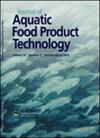Ultrasound-Mediated Technique for Facilitating Collagen Recovery from Yellowfin (Thunnus albacares) Skin: Insight into the Structure, Functional and Antioxidant Specification
IF 1.3
4区 农林科学
Q4 FOOD SCIENCE & TECHNOLOGY
引用次数: 0
Abstract
The highest yield (34%) and imino acid (18.7%) of collagen were obtained from yellowfin tuna (Thunnus albacares) skin using 20 min ultrasound. The collagen was identified as type I collagen accordi...利用超声波技术促进黄鳍鱼(Thunnus albacares)皮肤胶原蛋白的恢复:洞察结构、功能和抗氧化规范
利用 20 分钟超声波从黄鳍金枪鱼(Thunnus albacares)皮肤中获得了最高产量(34%)和亚胺酸(18.7%)的胶原蛋白。该胶原蛋白被鉴定为 I 型胶原蛋白,根据...
本文章由计算机程序翻译,如有差异,请以英文原文为准。
求助全文
约1分钟内获得全文
求助全文
来源期刊
CiteScore
3.50
自引率
6.20%
发文量
77
审稿时长
7 months
期刊介绍:
The Journal of Aquatic Food Product Technology publishes research papers, short communications, and review articles concerning the application of science and technology and biotechnology to all aspects of research, innovation, production, and distribution of food products originating from the marine and freshwater bodies of the world. The journal features articles on various aspects of basic and applied science in topics related to:
-harvesting and handling practices-
processing with traditional and new technologies-
refrigeration and freezing-
packaging and storage-
safety and traceability-
byproduct utilization-
consumer attitudes toward aquatic food.
The Journal also covers basic studies of aquatic products as related to food chemistry, microbiology, and engineering, such as all flora and fauna from aquatic environs, including seaweeds and underutilized species used directly for human consumption or alternative uses. Special features in the journal include guest editorials by specialists in their fields and book reviews covering a wide range of topics.

 求助内容:
求助内容: 应助结果提醒方式:
应助结果提醒方式:


